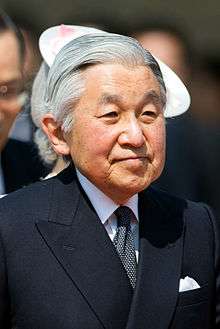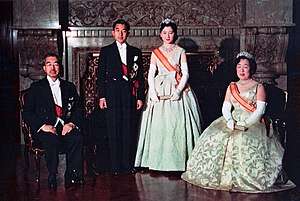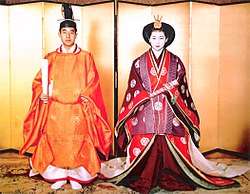Akihito
| Akihito | |||||
|---|---|---|---|---|---|
 The Emperor in 2014 | |||||
| Emperor of Japan | |||||
| Reign | 7 January 1989 – present | ||||
| Enthronement | 12 November 1990 | ||||
| Predecessor | Shōwa | ||||
| Heir apparent | Naruhito | ||||
| Prime Ministers | |||||
| Born |
23 December 1933 Tokyo Imperial Palace, Tokyo City, Empire of Japan | ||||
| Spouse | |||||
| Issue | |||||
| |||||
| House | Imperial House of Japan | ||||
| Father | Emperor Shōwa | ||||
| Mother | Empress Kōjun | ||||
| Signature |
 | ||||
 |
Akihito (明仁, Japanese: [akiçito]; ![]()
The Japanese government announced in December 2017 that Akihito would abdicate on 30 April 2019.[1]
Name
In Japan, the Emperor is never referred to by his given name, but rather is referred to as "His Majesty the Emperor" (天皇陛下 Tennō Heika) which may be shortened to His Majesty (陛下 Heika).[2] In writing, the Emperor is also referred to formally as "The Reigning Emperor" (今上天皇 Kinjō Tennō). The Era of Akihito's reign bears the name "Heisei" (平成), and according to custom he will be renamed Emperor Heisei (平成天皇 Heisei Tennō, see "posthumous name") by order of the Cabinet after his death. At the same time, the name of the next era under his successor will be established.[3] If the Emperor abdicates as planned, he will receive the title of Jōkō (上皇), an abbreviation of Daijō Tennō (太上天皇, Retired Emperor), and a new era will be established.[4][5]
Life and work
Akihito was born in the Tokyo Imperial Palace, Tokyo, Japan, and is the elder son and the fifth child of the Emperor Shōwa (Hirohito) and Empress Kōjun (Nagako). Titled Prince Tsugu (継宮 Tsugu-no-miya) as a child, he was raised and educated by his private tutors and then attended the elementary and secondary departments of the Peers' School (Gakushūin) from 1940 to 1952.[6] Unlike his predecessors in the Imperial family, he did not receive a commission as an army officer, at the request of his father, Hirohito.
During the American firebombing raids on Tokyo in March 1945, Akihito and his younger brother, Prince Masahito, were evacuated from the city. During the American occupation of Japan following World War II, Prince Akihito was tutored in the English language and Western manners by Elizabeth Gray Vining. He briefly studied at the Department of Political Science at Gakushuin University in Tokyo, though he never received a degree.
Akihito was heir-apparent to the Chrysanthemum Throne from the moment of his birth. His formal Investiture as Crown Prince (立太子礼 Rittaishi-no-rei) was held at the Tokyo Imperial Palace on 10 November 1952. In June 1953 Akihito represented Japan at the Coronation of Queen Elizabeth II in London.[6]
Crown Prince Akihito and Crown Princess Michiko made official visits to thirty-seven countries. As an Imperial prince, Akihito compared the role of Japanese royalty to that of a robot. He expressed the desire to help bring the Imperial family closer to the people of Japan.[7]
Upon the death of Emperor Hirohito on 7 January 1989, Akihito acceded (senso) to the throne,[8] with an enthronement ceremony taking place (sokui)[8] on 12 November 1990.[6] In 1998, during a state visit to the United Kingdom, he was invested with the UK Order of the Garter.
On 23 December 2001, during his annual birthday meeting with reporters, the Emperor, in response to a reporter's question about tensions with Korea, remarked that he felt a kinship with Koreans and went on to explain that, in the Shoku Nihongi, the mother of Emperor Kammu (736–806) is related to Muryeong of Korea, King of Baekje, a fact that was considered taboo.[9][10]
Emperor Akihito underwent surgery for prostate cancer on 14 January 2003.[11]
In response to the 2011 Tōhoku earthquake and tsunami and the Fukushima I nuclear crisis, the Emperor made a historic televised appearance[12] urging his people not to give up hope and to help each other.[13] The Emperor and Empress also made a visit on Wednesday, 30 March 2011 to a temporary shelter housing refugees of the disaster, in order to inspire hope in the people. This kind of event is also extremely rare, though in line with the Emperor's attempts to bring the Imperial family closer to the people.[14] Later in 2011 he was admitted to hospital suffering from pneumonia.[15] In February 2012 it was announced that the Emperor would be having a coronary examination;[16] he underwent successful heart bypass surgery on 18 February 2012.[17]
Marriage and family

In August 1957, he met Michiko Shōda[6][18] on a tennis court at Karuizawa near Nagano. The Imperial Household Council (a body composed of the Prime Minister of Japan, the presiding officers of the two houses of the Diet of Japan, the Chief Justice of Japan, and two members of the Imperial family) formally approved the engagement of the Crown Prince to Michiko Shōda on 27 November 1958. At that time, the media presented their encounter as a real "fairy tale",[19] or the "romance of the tennis court". It was the first time a commoner would marry into the Imperial Family, breaking more than 2,600 years of tradition.[20] The engagement ceremony took place on 14 January 1959, and the marriage on 10 April 1959.
The Emperor and Empress have three children: sons Naruhito, Crown Prince of Japan (born 23 February 1960 at Imperial Household Agency Hospital in Tokyo Imperial Palace ) and Fumihito, Prince Akishino (born 30 November 1965 at Imperial Household Agency Hospital in Tokyo Imperial Palace) and daughter Mrs. Sayako Kuroda (born 18 April 1969 at Imperial Household Agency Hospital, Tokyo Imperial Palace).[6]
The announcement about the then-Crown Prince Akihito's engagement and marriage to the then-Ms. Michiko Shōda drew opposition from traditionalist groups, because Shōda came from a Roman Catholic family.[21] Although Shōda was never baptized, she was educated in Catholic schools and seemed to share the faith of her parents. Rumors also speculated that Empress Kōjun had opposed the engagement. After the death of Empress Kōjun in 2000, Reuters reported that she was one of the strongest opponents of her son's marriage, and that in the 1960s, she had driven her daughter-in-law and grandchildren to depression by persistently accusing her of not being suitable for her son.[22]
Official functions
According to the Constitution of Japan, Akihito is "the symbol of the state and the unity of the (Japanese) people." Unlike other constitutional monarchs, his function is defined as entirely representative and ceremonial in nature, without even a nominal role in government. He is limited to acting in matters of state as delineated in the Constitution, and even in those matters, he is bound by the requirements of the Constitution and the binding advice of the Cabinet. For instance, while he formally appoints the Prime Minister, he is required to appoint the person designated by the Diet, without the option to decline appointment.
Despite being strictly constrained by his constitutional position, he also issued several wide-ranging statements of remorse to Asian countries, for their suffering under Japanese occupation, beginning with an expression of remorse to China made in April 1989, three months after the death of his father, Emperor Shōwa.
In June 2005, the Emperor visited the island of Saipan (part of the Northern Mariana Islands, a U.S. territory),[23] the site of a battle in World War II from 15 June to 9 July 1944 (known as the Battle of Saipan). Accompanied by Empress Michiko, he offered prayers and flowers at several memorials, honoring not only the Japanese who died, but also American soldiers, Korean laborers, and local islanders. It was the first trip by a Japanese monarch to a World War II battlefield abroad. The Saipan journey was received with high praise by the Japanese people, as were the Emperor's visits to war memorials in Tokyo, Hiroshima, Nagasaki and Okinawa in 1995.
Since succeeding to the throne, Akihito has made an effort to bring the Imperial family closer to the Japanese people. He and Michiko have made official visits to eighteen countries and to all forty-seven Prefectures of Japan.[6]
Succession
On 6 September 2006, the Emperor celebrated the birth of his first grandson, Prince Hisahito, the third child of the Emperor's younger son. Prince Hisahito is the first male heir born to the Japanese imperial family in 41 years (since his father Prince Akishino) and could avert a possible succession crisis as the Emperor's elder son, the Crown Prince Naruhito, has only one daughter, Princess Aiko. Under Japan's male-only succession law, Princess Aiko is not eligible for the throne. The birth of Prince Hisahito could mean that proposed changes to the law to allow Aiko to ascend the Chrysanthemum Throne will not go through after being temporarily shelved following the announcement of Princess Kiko's third pregnancy in February 2006.[24] The supporters of changes criticized the current law as it placed a burden on the few aging males old enough to perform royal duties as females left the family.[25]
Pending abdication
On 13 July 2016, national broadcaster NHK reported that the Emperor intended to abdicate in favor of his eldest son Crown Prince Naruhito within a few years, citing his age; an abdication within the Imperial Family has not occurred since Emperor Kōkaku in 1817. However, senior officials within the Imperial Household Agency denied that there was any official plan for the monarch to abdicate. Abdication by the Emperor required an amendment to the Imperial Household Law, which had no provisions for such a move.[26][27] On 8 August 2016, the Emperor gave a rare televised address, where he emphasized his advanced age and declining health;[28] this address was interpreted as an implication of his intention to abdicate.[29]
| Wikinews has related news: Japan's National Diet passes law allowing Emperor Akihito to abdicate within three years |
On 19 May 2017, the bill that would allow Akihito to abdicate was issued by the Japanese government's cabinet. On 8 June 2017, the National Diet passed a one-off bill allowing Akihito to abdicate, and for the government to begin arranging the process of handing over the position to Crown Prince Naruhito.[30] The Japanese government announced in December 2017 that Akihito would abdicate on 30 April 2019.[1] On 18 December 2017, the Imperial Household Agency confirmed that Akihito would move to Akasaka Palace upon abdication.
Ichthyological research
In extension of his father's interest in marine biology, the Emperor is a published ichthyological researcher, and has specialized in studies within the taxonomy of the family Gobiidae.[31] He has written papers for scholarly journals such as Gene and the Japanese Journal of Ichthyology.[32] He has also written papers about the history of science during the Edo and Meiji eras, which were published in Science[33] and Nature.[34] In 2005, a newly described goby was named Exyrias akihito in his honour, and in 2007 a genus Akihito Spp. of gobies native to Pacific islands also received his name.
- Member of the Ichthyological Society of Japan
- Foreign member of the Linnean Society of London (1980)
- Honorary member of the Linnean Society of London (1986)
- Research associate of the Australian Museum
- Honorary member of the Zoological Society of London (1992)
- Honorary member of the Research Institute for Natural Science of Argentina (1997)
- Honorary degree of the Uppsala University (2007)
Titles, styles, honours and arms
| Styles of Emperor Akihito | |
|---|---|
 | |
| Reference style | His Majesty |
| Spoken style | Your Majesty |
| Alternative style | Sir |
Titles and styles
- 23 December 1933 – 10 November 1952: His Imperial Highness The Prince Tsugu
- 10 November 1952 – 7 January 1989: His Imperial Highness The Crown Prince
- 7 January 1989 – present: His Majesty The Emperor
If the abdication goes as expected, Akihito's title will be "Daijō Tennō", or "Jōkō" in short.
Honours
- National honours


_1Class_BAR.svg.png)

.png)
.png)
- Foreign honours
- FR Yugoslavia split into Serbia and Montenegro. As of 2006 this order is аbolished.
- Zaire is now the Democratic Republic of the Congo.
- Other awards
Arms

Overseas visits
The following table includes the official visits made by Emperor Akihito, along with Empress Michiko, following succession to the throne on 7 January 1989.[51][52][53] The list includes all the visits made up to 31 December 2017. Although Empress Michiko has made two official visits on her own, in 2002 (To ![]()
![]()
| Serial no. | Date (Year) | Country | Purpose |
|---|---|---|---|
| 1 | 26 September – 6 October (1991) | "To foster friendly relations at the invitation of Thailand, Malaysia and Indonesia" | |
| 2 | 23 October – 28 October (1992) | "To foster friendly relations at the invitation of China" | |
| 3 | 6 August – 9 August (1993) | "To attend the funeral ceremony of King Baudouin of Belgium" | |
| 4 | 3 September – 19 September (1993) | "To foster friendly relations at the invitation of Italy, Belgium and Germany (Visit to the | |
| 5 | 10 June – 26 June (1994) | "To foster friendly relations at the invitation of the United States" | |
| 6 | 2 October – 14 October (1994) | "To foster friendly relations at the invitation of France and Spain" | |
| 7 | 30 May – 13 June (1997) | "To foster friendly relations at the invitation of Brazil and Argentina" | |
| 8 | 23 May – 5 June (1998) | "To foster friendly relations at the invitation of the United Kingdom and Denmark" | |
| 9 | 20 May – 1 June (2000) | "To foster friendly relations at the invitation of the Netherlands and Sweden" | |
| 10 | 6 July – 20 July (2002) | "To foster friendly relations at the invitation of Poland and Hungary" | |
| 11 | 7 May – 14 May (2005) | "To foster friendly relations at the invitation of Norway" | |
| 12 | 27 June – 28 June (2005) | "To pay tribute to those who died in the war and to pray for world peace in the 60th year after the end of the war" | |
| 13 | 8 June – 15 June (2006) | "To celebrate the 40th anniversary of the establishment of diplomatic relations at the invitation of Singapore and to attend celebrations for the 60th anniversary of the accession to the throne of King Bhumibol Adulyadej of Thailand" | |
| 14 | 21 May – 30 May (2007) | "To mark presence as a honorary member of the Linnean Society on the 300th birth anniversary of Carl von Linné at the invitation of Sweden and the United Kingdom and to foster friendly relations at the invitation of Estonia, Latvia and Lithuania" | |
| 15 | 3 July – 17 July (2009) | "To foster friendly relations at the invitation of Canada, and to celebrate the occasion of the 50th anniversary of the Crown Prince Akihito Scholarship Foundation (Visit to Hawaii)" | |
| 16 | 16 May – 20 May (2012) | "To attend a luncheon in commemoration of the Diamond Jubilee of Queen Elizabeth II at the invitation of Queen Elizabeth II" | |
| 17 | 30 November – 6 December (2013) | "To foster friendly relations at the invitation of India" | |
| 18 | 8 April – 9 April (2015) | "To pay tribute to those who died in the war and to foster international goodwill in the 70th year after the end of the war" | |
| 19 | 26 January – 30 January (2016) | "To foster friendly relations on the occasion of the 60th anniversary of the normalization of diplomatic relations at the invitation of the Philippines" | |
| 20 | 28 February – 6 March (2017) | "To foster friendly relations at the invitation of Vietnam" |
Issue
.jpg)
| Name | Birth | Marriage | Issue | |
|---|---|---|---|---|
| Naruhito, Crown Prince of Japan | 23 February 1960 | 9 June 1993 | Masako Owada | Aiko, Princess Toshi |
| Fumihito, Prince Akishino | 30 November 1965 | 29 June 1990 | Kiko Kawashima | Princess Mako of Akishino Princess Kako of Akishino Prince Hisahito of Akishino |
| Sayako, Princess Nori | 18 April 1969 | 15 November 2005 | Yoshiki Kuroda | |
Ancestors
| Ancestors of Akihito | ||||||||||||||||||||||||||||||||||||||||||||||||||||||||||||||||||||||||||||||||||||||||||||||||||||||||||||||||||||||||||||||||||||||||||||||||||||||||||||||||||||||||||||||||||||||||||||||||||||||||||||||||||||||||||||||||||||||||||||||||||||||||||||||||||||||||||||||||||||||||||||||||||||||||||||||||||||||||||||||||||||||||||||||||||||||||||||||||||||||||||||||||||||||||||||||||||||||||||||||||||||||||||||||||||||||||||||||||||||||||||||||||||||||||||||||||||||||||||||||||||||||||||||||||||||||||||||||||||||||||||||||||||||||||||||||||||||||||||||||||||||||||||||||||
|---|---|---|---|---|---|---|---|---|---|---|---|---|---|---|---|---|---|---|---|---|---|---|---|---|---|---|---|---|---|---|---|---|---|---|---|---|---|---|---|---|---|---|---|---|---|---|---|---|---|---|---|---|---|---|---|---|---|---|---|---|---|---|---|---|---|---|---|---|---|---|---|---|---|---|---|---|---|---|---|---|---|---|---|---|---|---|---|---|---|---|---|---|---|---|---|---|---|---|---|---|---|---|---|---|---|---|---|---|---|---|---|---|---|---|---|---|---|---|---|---|---|---|---|---|---|---|---|---|---|---|---|---|---|---|---|---|---|---|---|---|---|---|---|---|---|---|---|---|---|---|---|---|---|---|---|---|---|---|---|---|---|---|---|---|---|---|---|---|---|---|---|---|---|---|---|---|---|---|---|---|---|---|---|---|---|---|---|---|---|---|---|---|---|---|---|---|---|---|---|---|---|---|---|---|---|---|---|---|---|---|---|---|---|---|---|---|---|---|---|---|---|---|---|---|---|---|---|---|---|---|---|---|---|---|---|---|---|---|---|---|---|---|---|---|---|---|---|---|---|---|---|---|---|---|---|---|---|---|---|---|---|---|---|---|---|---|---|---|---|---|---|---|---|---|---|---|---|---|---|---|---|---|---|---|---|---|---|---|---|---|---|---|---|---|---|---|---|---|---|---|---|---|---|---|---|---|---|---|---|---|---|---|---|---|---|---|---|---|---|---|---|---|---|---|---|---|---|---|---|---|---|---|---|---|---|---|---|---|---|---|---|---|---|---|---|---|---|---|---|---|---|---|---|---|---|---|---|---|---|---|---|---|---|---|---|---|---|---|---|---|---|---|---|---|---|---|---|---|---|---|---|---|---|---|---|---|---|---|---|---|---|---|---|---|---|---|---|---|---|---|---|---|---|---|---|---|---|---|---|---|---|---|---|---|---|---|---|---|---|---|---|---|---|---|---|---|---|---|---|---|---|---|---|---|---|---|---|---|---|---|---|---|---|---|---|---|---|---|---|---|---|---|---|---|---|---|---|---|---|---|---|---|---|---|---|---|---|---|---|---|---|---|---|---|---|---|---|---|---|---|---|---|---|---|---|---|---|---|---|---|---|---|---|---|---|---|---|---|---|---|---|---|---|---|---|---|---|---|---|---|---|---|---|---|---|---|---|---|---|---|---|---|---|---|---|---|---|---|---|---|---|---|---|---|---|---|---|---|---|---|---|---|---|---|---|---|---|---|---|---|---|---|---|---|---|---|---|---|---|---|---|---|---|---|---|---|---|---|---|---|---|---|---|---|---|---|
| ||||||||||||||||||||||||||||||||||||||||||||||||||||||||||||||||||||||||||||||||||||||||||||||||||||||||||||||||||||||||||||||||||||||||||||||||||||||||||||||||||||||||||||||||||||||||||||||||||||||||||||||||||||||||||||||||||||||||||||||||||||||||||||||||||||||||||||||||||||||||||||||||||||||||||||||||||||||||||||||||||||||||||||||||||||||||||||||||||||||||||||||||||||||||||||||||||||||||||||||||||||||||||||||||||||||||||||||||||||||||||||||||||||||||||||||||||||||||||||||||||||||||||||||||||||||||||||||||||||||||||||||||||||||||||||||||||||||||||||||||||||||||||||||||
Patrilineal descent
| Patrilineal descent |
|---|
|
Akihito's patriline is the line from which he is descended father to son. Patrilineal descent is the principle behind membership in royal houses, as it can be traced back through the generations, which means that Akihito is a member of the Imperial House of Japan.
|
See also
References
- 1 2 Enjoji, Kaori (1 December 2017). "Japan Emperor Akihito to abdicate on April 30, 2019". CNN. Tokyo. Retrieved 1 December 2017.
- ↑ "Members of the Order of the Garter". The British Monarchy.
- ↑ "National Day of Japan to be celebrated". Embassy of Japan in Pakistan. 7 December 2007. Archived from the original on 2 February 2008. Retrieved 28 December 2007.
- ↑ "Government panel outlines proposals on Emperor's abdication, titles". The Japan Times Online. 14 April 2017. Retrieved 9 June 2017.
- ↑ "Japan may announce new Imperial era name in summer 2018". The Japan Times. 19 May 2017. Retrieved 31 May 2017.
- 1 2 3 4 5 6 "Their Majesties the Emperor and Empress". Imperial Household Agency. 2002. Archived from the original on 1 December 2007. Retrieved 28 December 2007.
- ↑ "Those Apprentice Kings and Queens Who May – One Day – Ascend a Throne," The New York Times. 14 November 1971.
- 1 2 Varley, H. Paul. (1980). Jinnō Shōtōki, p. 44.
- ↑ "Press Conference on the Occasion of His Majesty's Birthday". Imperial Household Agency. Archived from the original on 25 May 2008. Retrieved 7 July 2008.
- ↑ Chotiner, Isaac (8 August 2016). "What Does the Japanese Emperor Do? And will Japan let him stop doing it?". Slate.
- ↑ "Akihito has successful cancer operation". BBC News. BBC. 18 January 2003. Retrieved 28 December 2007.
- ↑ "Six days later, Japanese still confronting magnitude of quake crisis". CNN. 29 April 2011.
- ↑ "Message from His Majesty The Emperor". The Imperial Household Agency. 16 March 2011. Retrieved 9 August 2016.
- ↑ Japanese Emperor visits evacuation center Archived 14 March 2012 at the Wayback Machine.
- ↑ "Japan's Emperor Akihito leaves Tokyo hospital". BBC News. 24 November 2011. Retrieved 24 January 2012.
- ↑ "Emperor Akihito to have coronary examination". Mainichi Daily News. 1 February 2012. Archived from the original on 14 July 2012.
- ↑ "Report: Japan's Emperor undergoes successful cardiac bypass". CNN. 18 February 2012.
- ↑ Fukada, Takahiro, "Emperor — poise under public spotlight", Japan Times, 24 November 2009, p. 3.
- ↑ « The Girl from Outside », Time, 23 March 1959
- ↑ "The wedding that broke centuries of tradition". BBC News. 2017-09-01. Retrieved 2017-09-01.
- ↑ Herbert P. Bix, "Hirohito and the Making of Modern Japan", New York, 2001, p. 661
- ↑ "Japan's Dowager Empress Dead At 97". CBS News. 2000-06-16. Retrieved 2016-10-21.
- ↑ Brooke, James (28 June 2005). "Visiting Saipan, Japan's Emperor Honors Dead". New York Times. Retrieved 9 August 2013.
- ↑ Yoshida, Reiji (27 March 2007). "Life in the cloudy Imperial fishbowl". Japan Times. Retrieved 28 May 2017.
- ↑ "The Future of Japan's Dwindling Imperial Family". Retrieved 26 July 2014.
- ↑ "天皇陛下 「生前退位」の意向示される ("His Majesty The Emperor Indicates His Intention to 'Abdicate'")" (in Japanese). NHK. 13 July 2016. Archived from the original on 13 July 2016. Retrieved 13 July 2016.
- ↑ "Japanese Emperor Akihito 'wishes to abdicate'". BBC News. 13 July 2016. Retrieved 17 July 2016.
- ↑ "Message from His Majesty The Emperor". The Imperial Household Agency. 8 August 2016. Retrieved 8 August 2016.
- ↑ "Japan's Emperor Akihito hints at wish to abdicate". BBC News. 8 August 2016. Retrieved 8 August 2016.
- ↑ "Japan passes landmark bill for Emperor Akihito to abdicate". BBC News. 8 June 2017.
- ↑ Hamilton, Alan. "Palace small talk problem solved: royal guest is a goby fish fanatic", The Times (London). 30 May 2007
- ↑ PubMed Search Results Archived 10 May 2012 at the Wayback Machine.
- ↑ Akihito (October 1992). "Early cultivators of science in Japan". Science. 258 (5082): 578–80. doi:10.1126/science.1411568. PMID 1411568.
- ↑ His Majesty The Emperor of Japan (July 2007). "Linnaeus and taxonomy in Japan". Nature. 448 (7150): 139–140. doi:10.1038/448139a. PMID 17632886.
- ↑ "Bundeskanzler Anfragebeantwortung" [Reply to a parliamentary question about the Decoration of Honour] (PDF) (in German). p. 1298. Retrieved 27 January 2017.
- ↑ Persondetaljer - Hans Kejserlige Højhed Akihito Archived 29 May 2012 at the Wayback Machine.. borger.dk.
- ↑ "Akihito". Bearers of decorations. president. Retrieved 18 January 2011.
- ↑ Presidency, table Archived 10 May 2013 at the Wayback Machine. of recipients of the Order of the Three Stars since 2004.
- ↑ Decree 1K-974
- ↑ Omsa.org
- ↑ Embassy of Japan in Nepal
- ↑ Volkskrant, State visit of Netherlands in Japan, 1991, Group Photo
- ↑ The Royal Forums, State visit of Japan in Norway, May 2005, Photo
- ↑ OPS.gov.ph Archived 17 August 2008 at the Wayback Machine.
- ↑ Gov.ph Archived 13 October 2016 at the Wayback Machine.
- ↑ "Cidadãos Estrangeiros Agraciados com Ordens Portuguesas" (in Portuguese). presidencia.pt. Retrieved 6 January 2011.
- ↑ Sahistory
- ↑ "Noblesse et Royautés" Archived 28 January 2016 at the Wayback Machine. (French), State visit of Spain in Japan, November 2008
- ↑ Getty Images, State visit of Sweden in Japan, 03/2007, Group photo
- ↑ reinanzaka-sc.o.oo7.jp/kiroku/documents/20140523-3-kiji-list.pdf
- ↑ "List of Overseas visits by the Emperor and Empress (1989 - 1998)". The Imperial Household Agency. Retrieved 23 June 2018.
- ↑ "List of Overseas visits by the Emperor and Empress (1999 - 2008)". The Imperial Household Agency. Retrieved 23 June 2018.
- ↑ "List of Overseas visits by the Emperor and Empress (2009 or later)". The Imperial Household Agency. Retrieved 23 June 2018.
- ↑ "Ancestry in Genealogics.org". Archived from the original on 2013-04-15.
External links
| Wikiquote has quotations related to: Akihito |
| Wikimedia Commons has media related to Emperor Akihito. |
| Wikinews has related news: Japanese Emperor makes live television appearance after earthquake |
- Their Majesties the Emperor and Empress at the Imperial Household Agency website
- Press Conference on the occasion of His Majesty's Birthday (2016)
- Complete transcript (U.S. English and Japanese) and audio mp3 and video of 'Do Not Lose Hope' Address to the Nation at AmericanRhetoric.com
- www.sunstar.com.ph/network/news/2017/10/20/japan-emperor-abdication-set-march-2019-570435
Akihito Born: 23 December 1933 | ||
| Regnal titles | ||
|---|---|---|
| Preceded by Shōwa (Hirohito) |
Emperor of Japan 1989–present |
Incumbent Heir apparent: Naruhito |
| Order of precedence in Japan | ||
| First | Gentlemen as the Sovereign |
Succeeded by The Crown Prince |


